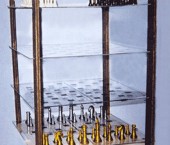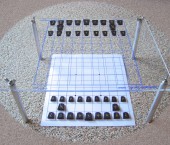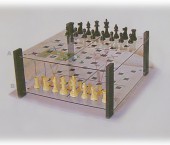Welcome!
You are now entering
another dimension of strategy.
A strategy which involves more
than one board — in a game.Just when you thought it was safe
to play strategy games…Discover
The Final Frontier
of the
Third Dimension.
You are now entering the Dimensional Zone
‘Chess — The Next Generation’
The game of chess has not changed for a long time. “Chess — The Next Generation” has only added an additional board and uses all the same official rules for chess. However, because of the dimensional factor(the extra board), there is a need for additional instructions as to how the pieces move dimensionally.
‘Chess — The Future Generation’
 In “Chess — The Future Generation”, there are two additional boards added to the game of “Chess — The Next Generation”. It relies on all those instructions. In addition, this game is played in teams. White and Gold play as a team vs Black and Silver as the other team (could also be played by 2 persons). However, because of the sequence of play, 4 boards and two more Kings, there is a need for additional instructions for the success of the game.
In “Chess — The Future Generation”, there are two additional boards added to the game of “Chess — The Next Generation”. It relies on all those instructions. In addition, this game is played in teams. White and Gold play as a team vs Black and Silver as the other team (could also be played by 2 persons). However, because of the sequence of play, 4 boards and two more Kings, there is a need for additional instructions for the success of the game.
‘3‑D Checkers — The Next Generation’
 “3‑D Checkers — The Next Generation” relies on the official rules for Checkers. The only change is the fact that there are three more boards added. The game also may be played by 2, 3, or 4 players in teams or everyone for themselves. When playing 3 players the black is removed and the blue pieces are put along the back row of all 4 boards. However because of the dimensional factor, there is a need for additional instructions as to how the pieces move dimensionally. Teams: Black/Green vs Red/Blue. Black moves 1st then Red, Blue, Green, in that order at all times.
“3‑D Checkers — The Next Generation” relies on the official rules for Checkers. The only change is the fact that there are three more boards added. The game also may be played by 2, 3, or 4 players in teams or everyone for themselves. When playing 3 players the black is removed and the blue pieces are put along the back row of all 4 boards. However because of the dimensional factor, there is a need for additional instructions as to how the pieces move dimensionally. Teams: Black/Green vs Red/Blue. Black moves 1st then Red, Blue, Green, in that order at all times.‘Shogi — The Next Generation’
 “Shogi — The Next Generation” relies on the official rules for Shogi. The only change is the addition of one more board to the game. Everything else is the same. However because of the dimensional factor, there is a need for additional instructions as to how the pieces move dimensionally. Really, though, the game follows the same concept as ‘Chess — The Next Generation’.
“Shogi — The Next Generation” relies on the official rules for Shogi. The only change is the addition of one more board to the game. Everything else is the same. However because of the dimensional factor, there is a need for additional instructions as to how the pieces move dimensionally. Really, though, the game follows the same concept as ‘Chess — The Next Generation’.The difference between 2D and 3D?
2D Chess Board:
You can Hide
but you can’t Run.
3D Chess Board:
You can Run
but you can’t Hide.
FOUR IN A ROW (tickle tac toe)
By using 4 squares by 4 squares by 4 levels “A” — “D”, the first person to get in a straight line 4 of his own checker pieces in a row horizontally (on a level), vertically, or diagonally, wins. This can be done with the black and red checker pieces to play 2 persons or teams. For 3 or 4 players include the blue and green checker pieces. It’s a simple game but can get quite complex.
So what’s the reason to play games in 3D?
Is there any benefit other than a great game?
Chess is the only game where there have been 1000’s of studies to show that there are benefits. So too by extension, the games that are similar. Therefore, how much more so a game played in 3D! When playing a game in 3D it teaches someone to think dimensionally or spacial thinking. The benefits in learning are transferred into careers such as ‘Technical Drawing’ or ‘Interior Decorating’ all which require spacial thinking. There is cubical space in a room not just floor space!

